
When your business is growing fast, having a strong brand development strategy isn’t just an option—it’s a necessity. A well-defined brand ensures your business stays memorable, credible, and scalable. If your branding lacks clarity, customers will overlook you. Let’s explore key strategies to build a brand that stands out, resonates with audiences, and grows without losing its identity.
What Brand Development Really Means
Brand development isn’t just about logos and slogans—it’s about crafting a lasting impression. Your brand is the experience, trust, and perception people associate with your business. A strong brand identity builds loyalty and sets you apart in a crowded market. Let’s move beyond aesthetics and focus on strategies that make your brand truly unforgettable.
Why a Brand Development Strategy is Essential for Scaling
Rapid growth can dilute your brand’s identity. As you expand, you risk confusing customers with inconsistent messaging. A well-structured brand development strategy keeps your vision clear, ensuring customers recognize and connect with your business. Without it, you may lose brand loyalty, credibility, and uniqueness.
8 Powerful Strategies for Brand Development Success
1. Define Your Core Values and Mission
If you’re unsure what your brand stands for, your customers will be too. Clearly define your values, purpose, and unique promise to establish trust and authenticity.
Example: An organic food store committed to sustainable sourcing will attract eco-conscious buyers who share those values.
➡ Action Step: Write down three core values that shape your brand and build your messaging around them.
2. Create a Strong and Consistent Visual Identity
Visual branding builds recognition and trust. Your logo, colors, fonts, and design style should be cohesive across all platforms.
Example: Coca-Cola’s red-and-white branding is instantly recognizable, reinforcing its identity worldwide.
➡ Action Step: Develop a brand style guide to maintain consistency in visual elements.
3. Use SEO to Boost Brand Visibility
SEO isn’t just about ranking—it’s about ensuring your brand gets found and trusted. Create high-quality content using relevant keywords, meta tags, and strategic internal linking.
Example: A sustainable fashion brand publishing blogs on “eco-friendly fashion trends” attracts customers searching for sustainable options.
➡ Action Step: Research keywords and integrate them naturally into your content.
4. Build Social Proof for Brand Credibility
Customers trust each other more than they trust businesses. Leverage testimonials, reviews, and case studies to establish credibility.
Example: A tech startup sharing success stories of how clients benefited from their service builds strong trust.
➡ Action Step: Regularly showcase customer feedback and real-world success stories.
5. Evolve Your Brand Message as You Scale
Your brand must evolve with your business. As you expand to new markets or audiences, refine your messaging to stay relevant.
Example: A software company originally targeting startups may need to adjust its messaging as it attracts larger enterprises.
➡ Action Step: Conduct customer surveys to refine your brand voice and messaging.
6. Enhance Customer Experience at Every Touchpoint
A seamless customer experience strengthens brand loyalty. Every interaction—**website navigation, customer service, social media engagement—**should be optimized for a positive experience.
Example: Zappos built its brand around legendary customer service, making it a go-to for online shoe shopping.
➡ Action Step: Map out customer interactions and improve pain points.
7. Tell Stories That Make Your Brand Unforgettable
People remember stories, not advertisements. Share authentic narratives about your brand’s journey, challenges, and values.
Example: Warby Parker disrupted the eyewear industry by telling the story of making glasses more affordable without compromising quality.
➡ Action Step: Create a compelling brand story and share it across platforms.
8. Stay Ahead by Spotting Industry Trends
A strong brand isn’t static—it evolves with industry trends and customer preferences. Innovation and adaptability keep your brand ahead of competitors.
Example: An artisan bakery offering gluten-free options taps into the rising health-conscious trend, expanding its customer base.
➡ Action Step: Monitor trends with Google Alerts, competitor research, and customer feedback.
Case Studies: Brands That Excelled in Brand Development
- Patagonia: Built a strong eco-conscious brand by emphasizing environmental responsibility.
- Allbirds: Created a loyal following by promoting sustainable footwear.
- Dollar Shave Club: Disrupted the grooming industry with bold, humorous branding.
Final Thoughts
A well-executed brand development strategy ensures your brand remains memorable, consistent, and scalable. Whether you’re a startup or an expanding business, these tactics will help you build a brand that stands the test of time.

